Markets move faster than annual plans. While you’re executing, customer needs shift and new competitors emerge, leaving your teams reacting instead of leading. This execution gap creates uncertainty and slows progress.
Business agility gives you the competitive edge to sense market changes, adapt quickly, and deliver value continuously. Rather than fighting change, you’ll build an operating model that turns unpredictability into growth opportunities.
This guide covers essential business agility components — from flexible structures to continuous learning culture — with practical implementation strategies and solutions to common challenges. You’ll discover how the right work platform creates the visibility and structure needed to build a faster, more aligned organization that executes with confidence.
Key takeaways
- Build adaptability into every layer: business agility empowers organizations to sense change early, respond faster, and continuously deliver value in dynamic markets.
- Empower teams for faster execution: distributed decision-making and transparent communication help teams act quickly and stay aligned on shared goals.
- Foster a culture of learning and experimentation: continuous improvement turns failures into insights, driving innovation and long-term growth.
- Leverage monday work management for agility at scale: real-time dashboards, automations, and integrations provide visibility, structure, and flexibility to adapt with confidence.
- Turn disruption into opportunity: by combining customer focus, flexible structures, and data-driven decisions, businesses strengthen resilience and gain a lasting competitive edge.
What is business agility?
Business agility is an organization’s ability to sense market shifts, adapt rapidly, and deliver value without interruption. It is a defining capability in today’s environment, as research shows that Agile organizations are 70% more likely to be in the top quartile of organizational health — the strongest indicator of sustainable performance.
Achieving business agility requires moving beyond rigid annual planning toward flexible structures that respond to customer needs in real time. It is the difference between steering a cruise ship and piloting a speedboat: traditional organizations turn slowly, while an Agile workplace adjusts direction quickly and keeps momentum steady, no matter how conditions change.
Business agility and the three core actions
Business agility means building an organization that thrives on change rather than resists it. You create systems that detect shifts early, adjust strategies fast, and keep delivering value no matter what happens in your market.
The framework rests on three core actions that reinforce each other:
- Sensing: you monitor customer behavior, track competitor moves, and watch market trends to spot changes before they become problems.
- Adapting: you shift resources, adjust priorities, and modify processes based on what you learn.
- Delivering: you maintain quality and service levels even while everything else changes around you.
Business agility vs Agile methodology
Business agility and Agile methodology sound similar but serve different purposes. Agile methodology focuses on how software teams deliver projects through sprints and iterations. Business agility takes those principles and scales them across your entire organization.
Here’s how they compare:
| Aspect | Agile methodology | Business agility |
|---|---|---|
| Scope | Software teams and projects | Entire organization |
| Focus | Sprint cycles and deliverables | Market responsiveness and strategy |
| Timeline | 2-4 week sprints | Continuous adaptation |
| Leadership | Scrum masters and product owners | Executives and cross-functional leaders |
Business agility vs project management
Project management gives you control over defined work with clear start and end points. Business agility helps you navigate ongoing change and uncertainty. Both have value in business management — the key is knowing when to use each approach.
Project management works when you know exactly what needs to be built. Business agility shines when markets shift and customer needs evolve faster than your planning cycles.
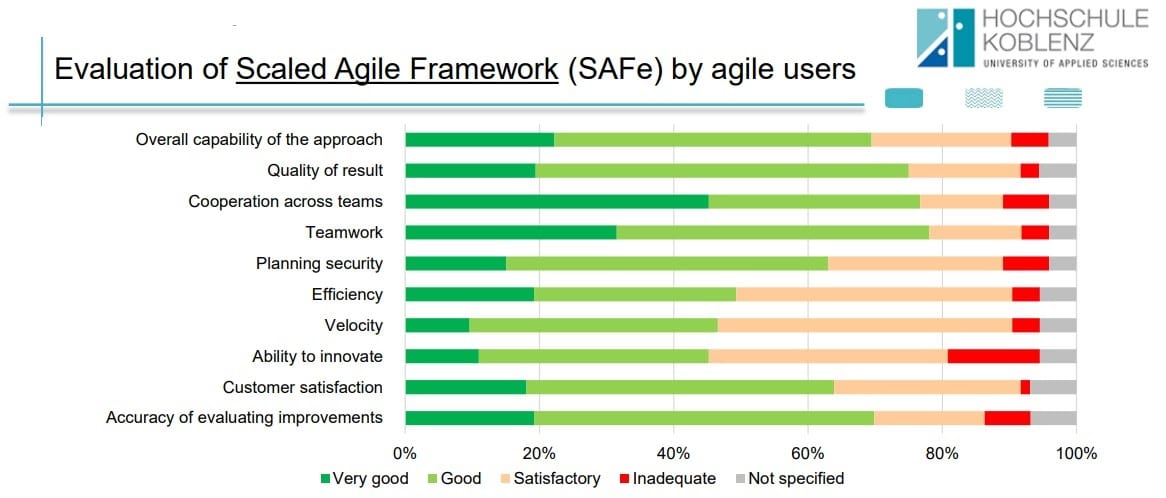
Why business agility matters today
The pace of business has never been faster. Markets evolve in weeks, customer expectations shift overnight, and emerging technologies constantly reshape how organizations operate. Keeping up is no longer enough — success depends on the ability to adapt, learn, and respond in real time.
Business agility makes that possible. It gives organizations the flexibility to handle disruption, the structure to scale innovation, and the insight to make better decisions faster. Whether it is navigating unpredictable markets, driving digital transformation, or building lasting competitive advantage, agility has become the foundation for sustained growth.
Adapting to rapid market changes
Disruption is now part of everyday business. Supply chains shift, customer preferences evolve, and new competitors appear faster than annual plans can adjust. Organizations that rely on rigid strategies struggle to keep pace, while those built on agility stay ahead by detecting and responding to change early.
Agile organizations:
- Monitor customer sentiment and market signals continuously rather than waiting for quarterly reviews.
- Test and refine new ideas in short cycles to learn what works faster.
- Shift resources and priorities quickly to capture emerging opportunities.
Platforms like monday work management make this possible by providing real-time visibility and connected workflows that help teams recognize shifts early and respond with confidence.
Meeting digital transformation demands
Technology alone won’t transform your business. You need Agile structures backed by a solid operations strategy that helps teams adopt new tools, learn from results, and scale what works. Otherwise, you’ll invest millions in platforms that sit unused because your processes can’t keep up.
AI adoption shows this clearly. Organizations with Agile foundations integrate AI into workflows naturally, accelerating AI transformation across their business. Rigid organizations find it challenging to scale beyond pilots, whereas Agile ones can more easily integrate new systems.
Building competitive advantage
Speed compounds. While competitors debate strategy in boardrooms, Agile organizations are already testing solutions with customers. This creates advantages that grow stronger over time:
- Faster decisions: you cut through bureaucracy to act on opportunities immediately.
- Deeper customer insights: you learn from real behavior, not outdated research.
- Smarter resource use: you shift investment to what’s working, not what was planned.
6 key benefits of business agility
When organizations embrace agility, they unlock measurable gains in organizational efficiency that extend across every level of the business. These improvements do not happen in isolation — each one reinforces the next, creating a continuous cycle of speed, learning, and adaptability.
From faster decisions to stronger innovation and more engaged teams, business agility builds the momentum needed to perform consistently in changing markets. The sections below outline six key benefits that show how agility turns adaptability into a lasting competitive advantage.
Faster decision-making and execution
Agile organizations push decisions down to teams closest to the work. This eliminates the delays that kill momentum in traditional hierarchies.
Your teams act within clear boundaries instead of waiting for approval chains. Information flows freely rather than getting stuck in silos. Problems are solved directly by the teams involved, promoting faster resolution.
Enhanced innovation capabilities
Innovation becomes systematic rather than sporadic. Your teams test ideas constantly, learn from results quickly, and scale successes rapidly.
This happens through:
- Protected experimentation time: teams explore new approaches without sacrificing current work.
- Rapid prototyping: ideas move from concept to testing in days or weeks.
- Learning from failure: unsuccessful experiments become valuable data, not career risks.
Optimized resource allocation
Agile organizations move away from rigid annual budgets that quickly become outdated. Instead, they allocate people and funding dynamically, directing resources where they create the most impact. This flexibility helps teams respond to new priorities without slowing down or wasting capacity.
Platforms like monday work management make this possible by giving leaders real-time visibility into workloads and available capacity. With clear insight into where resources are stretched or underused, teams can make faster, data-driven adjustments that keep execution aligned with business goals.
Increased employee engagement
People work harder when they control how work gets done. Agile structures give teams autonomy within boundaries, connecting their efforts directly to outcomes that matter.
Cross-functional collaboration exposes employees to different parts of your business. They develop new skills, build broader networks, and see how their work impacts customers.
Improved customer satisfaction
By responding to customer needs faster, you can significantly improve their experience. Organizations that successfully adopt Agile practices at scale report a 30% improvement in customer satisfaction and a 50% reduction in time to market. This is because feedback loops shorten from months to weeks, and problems get fixed before they can damage relationships.
Greater organizational resilience
In a constantly changing market, setbacks are inevitable — but agile organizations recover faster and often emerge stronger. They build resilience through distributed decision-making that removes single points of failure and empowers teams to act quickly when disruptions occur. Cross-trained employees and transparent communication ensure that work continues smoothly, even when conditions shift unexpectedly.
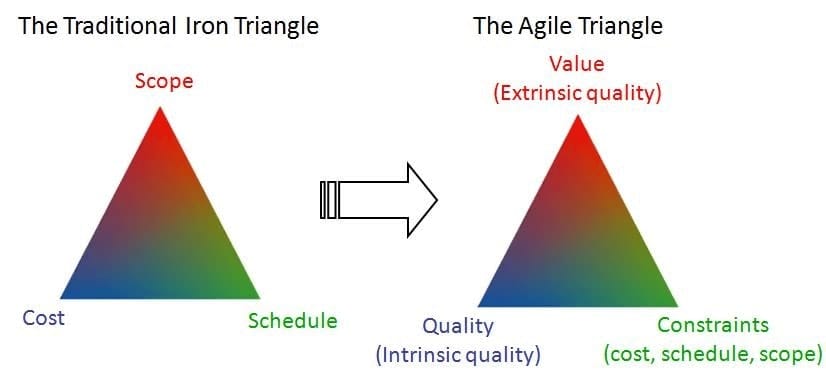
Business agility vs traditional business models
Every organization must balance stability with adaptability, but the emphasis determines how effectively it can respond to change. Traditional business models are built for control and predictability, prioritizing efficiency in steady conditions. In contrast, business agility thrives in uncertainty, focusing on flexibility, experimentation, and continuous improvement.
The table below highlights the key differences between these two approaches: showing how agile models evolve the traditional structure to support faster decisions, stronger collaboration, and ongoing learning.
| Element | Traditional model | Business agility model |
|---|---|---|
| Structure | Fixed hierarchies and departments | Flexible teams and networks |
| Planning | Annual budgets and strategies | Quarterly adjustments and experiments |
| Decision-making | Top-down approval chains | Distributed authority with boundaries |
| Performance | Annual reviews and fixed metrics | Continuous feedback and adaptive goals |
| Change | Formal control processes | Built-in adaptation capabilities |
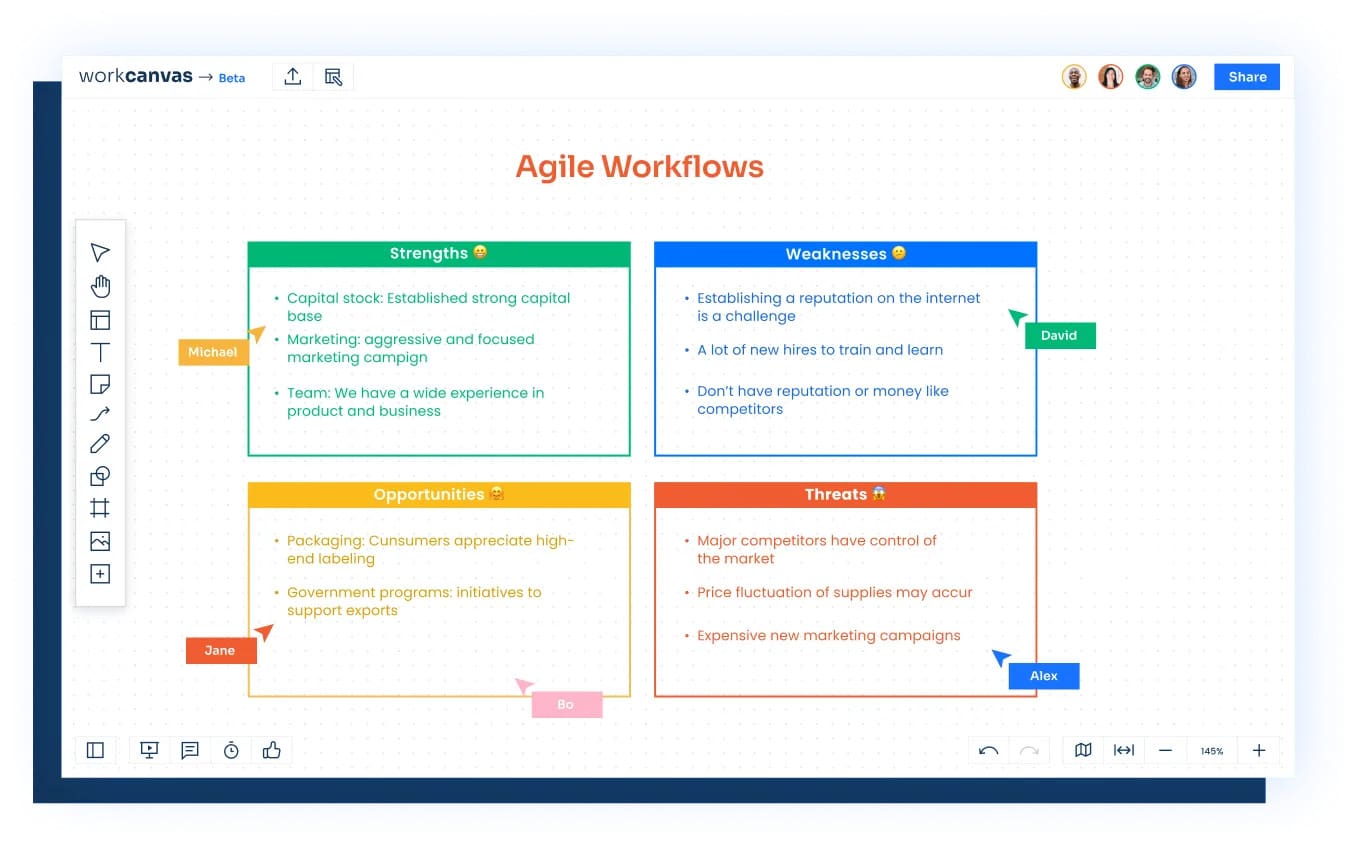
5 core components of business agility
Achieving true business agility requires more than adopting a few agile practices — it depends on building a connected system where leadership, structure, culture, technology, and customer focus all work together. Each component reinforces the others, creating the foundation for an organization that learns, adapts, and delivers value continuously.
The five components below outline how these elements combine to turn agility from a concept into a sustainable way of operating.
1. Agile leadership and governance
Leaders coach rather than command. They create safety for experimentation and trust teams to make decisions within boundaries.
Governance adapts to support this speed:
- Outcome focus: you measure results, not activities.
- Rapid reviews: weekly check-ins replace monthly reports.
- Open communication: strategy, performance, and challenges become visible to all.
2. Flexible organizational structure
Agile organizations are built around customer value, not rigid departments. Cross-functional teams bring together all the skills needed to deliver complete solutions, reducing handoffs and increasing accountability. This structure allows work to move faster and stay aligned with evolving customer needs.
Platforms like monday work management make this approach practical by connecting teams across marketing, sales, operations, and support in shared workspaces. With visibility into goals, progress, and dependencies, everyone can collaborate around outcomes rather than functions: turning flexibility into a daily reality.
3. Continuous learning culture
Learning becomes your competitive advantage. Teams experiment constantly, share insights openly, and apply lessons immediately.
You build this culture through:
- Safe experimentation: failures become learning, not blame.
- Knowledge sharing: best practices spread quickly across teams.
- Skill development: people grow capabilities continuously.
4. Technology-enabled processes
Technology brings agility to life by translating principles into daily action. The right tools automate repetitive tasks, surface real-time data, and connect systems that once operated in isolation — all of which accelerate decision-making and execution.
With monday work management, teams can build automated workflows, track performance instantly, and integrate their entire tech stack in one place. This unified approach keeps information flowing freely and ensures every process supports faster, smarter ways of working.
5. Customer-centric approach
Every decision starts with customer impact. You map value streams from the customer’s perspective. Feedback drives priorities rather than internal politics.
Common business agility challenges
Every organization faces barriers when building agility. Recognizing these challenges helps you address them systematically rather than getting stuck.
Breaking down organizational silos
When information stays locked within departments, progress slows and resources go to waste. True agility requires transparency: where teams share context, align on priorities, and move together toward common goals.
monday work management enables this by giving every team a clear view of projects, ownership, and outcomes. With shared visibility and connected workflows, enterprise collaboration becomes effortless, breaking down silos and turning alignment into everyday practice.
Overcoming resistance to change
People resist change when they don’t understand why it’s happening or how it helps them. This presents an opportunity for alignment as research shows that while 45% of senior leaders feel change is managed well, only 23% of individual contributors believe change is managed ‘very well’.
It’s always good practise to address concerns directly through clear communication about benefits, while it’s also vital to follow a structured change management process during transitions.
Successful change happens through:
- Clear rationale: explain why change matters for the organization and individuals.
- Inclusive design: involve affected teams in creating new approaches.
- Gradual rollout: test changes with willing teams before expanding.
Scaling Agile beyond IT teams
Agile started in software but applies everywhere. Marketing teams run campaign sprints, often guided by an Agile coach. Finance teams use rolling forecasts. HR teams iterate on hiring processes.
Each function adapts Agile principles to their context while maintaining business alignment with organizational goals.
Managing competing priorities
Multiple initiatives compete for the same resources. Without clear criteria, everything becomes urgent. Teams burn out trying to do everything at once.
You manage priorities through transparent criteria everyone understands. Regular reviews ensure priorities reflect current reality rather than outdated plans.

7 business agility implementation strategies
Building business agility requires systematic progress through seven key steps. Each builds on the previous while preparing for what comes next.
Step 1: secure leadership alignment
Leaders must understand and commit to Agile transformation. This means more than approval — they need to model Agile behaviors and provide resources for change.
Step 2: assess organizational agility maturity
Understand where you’re starting. Evaluate current structures, processes, culture, and technology to identify strengths and gaps.
Step 3: build cross-functional teams
Form teams with all skills needed to deliver value. Give them clear missions and authority to act within boundaries.
Step 4: deploy Agile operating models
Implement iterative planning, daily coordination, and regular retrospectives. Create rhythms that support process improvement.
Step 5: invest in digital platforms and tools
Choose platforms that enable rather than constrain agility. Monday work management provides the flexibility teams need with the structure organizations require.
Step 6: foster experimentation and innovation
Allocate time and resources for trying new approaches. Celebrate learning from failures as much as successes.
Step 7: measure progress and iterate
Track outcomes that matter to your business, as this transparency has a direct impact on morale.
In fact, employees who understand how success is measured are twice as likely to feel motivated. Adjust your approach based on what you learn. Keep improving rather than declaring victory.
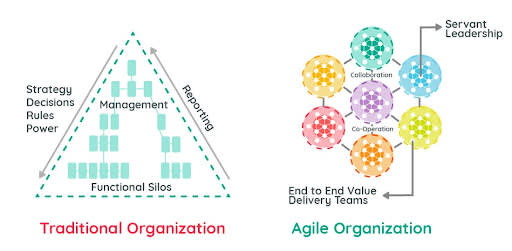
Measuring business agility success
You can’t improve what you don’t measure. Focus on metrics that show real business impact rather than just process adoption.
Key performance indicators
Track metrics that reflect agility outcomes:
- Speed metrics: how fast you launch products, make decisions, and respond to customers.
- Quality metrics: customer satisfaction, solution effectiveness, and error rates.
- Adaptability metrics: success rate of changes and strength of innovation pipeline.
Maturity assessment models
Regular risk assessment shows progress over time. Evaluate leadership practices, organizational flexibility, process adaptability, learning culture, and technology integration.
ROI tracking methods
Connect agility investments to business results. Track cost savings from efficiency, revenue from faster launches, and value from reduced risks.
Essential business agility platforms and technologies
Technology is the backbone of business agility, enabling teams to move faster, stay aligned, and make smarter decisions. The right tools enhance collaboration, automate routine work, and provide real-time insight into performance. Investing in workflow management software that connects people, data, and processes is key to turning agility from strategy into daily practice.
The sections below highlight the core technologies that support agile organizations — from integrated work management platforms to advanced analytics, communication tools, and AI-driven automation.
Work management platforms
Platforms like monday work management provide the foundation for Agile best practices. They enable visibility across projects, automate routine work, and connect teams regardless of location.
Collaboration and communication tools
Modern teams need video conferencing, instant messaging, and document sharing that work seamlessly together. Integration with work management platforms keeps communication connected to actual work.
Analytics and reporting solutions
Real-time dashboards show what’s happening now, not last quarter. Predictive analytics help you prepare for what’s coming. Monday work management builds these capabilities directly into your workflows.
AI-powered automation
AI handles routine decisions and surfaces insights humans might miss. It categorizes feedback, predicts risks, and suggests next actions based on patterns in your data.
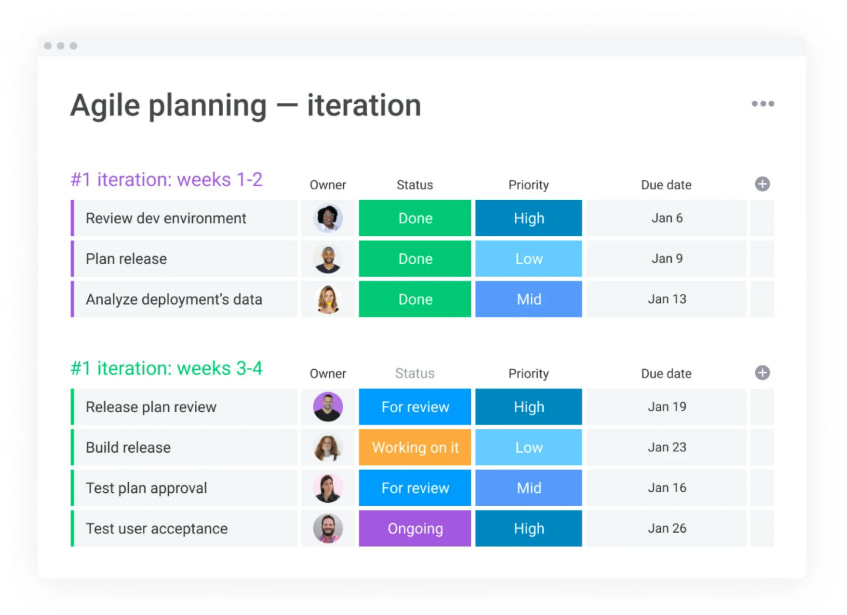
Achieve business agility with monday work management
Reaching true business agility requires the right balance between flexibility and structure: a system that empowers teams to move quickly while staying aligned on goals. The right work management platform creates that foundation, connecting people, processes, and data in one shared environment.
With monday work management, organizations can scale agile practices across teams, automate routine tasks, and make data-driven decisions with confidence. The sections below outline how its core capabilities — from advanced automation and integrations to AI-powered insights and real-time visibility — help teams work faster, stay connected, and adapt continuously.
Advanced automations for Agile execution
Eliminate manual handoffs that slow your team down with automations that keep work flowing without constant supervision. Create custom recipes that trigger exactly when needed:
- Status-based triggers: automatically notify stakeholders when projects move to new stages.
- Time-based actions: schedule recurring tasks and reminders that keep work on track.
- Conditional logic: build complex workflows that adapt to different scenarios automatically.
200+ integrations for connected ecosystems
Connect your entire tech stack to eliminate the silos that kill agility. With over 200 native integrations, your critical tools work together seamlessly:
- Development tools: sync with GitHub, Jira, and other technical platforms.
- Marketing systems: connect CRM, email, and analytics platforms for unified customer views.
- Communication channels: integrate Slack, Teams, and Zoom to keep conversations connected to work.
Powerful AI features that accelerate adaptation
Leverage AI to handle routine tasks and surface insights that help you adapt faster to changing conditions:
- Smart summaries: instantly capture key points from lengthy discussions and documents.
- Predictive analytics: identify potential bottlenecks before they impact delivery
- Content generation: create project briefs, update templates, and draft communications faster.
Real-time visibility for Agile decision-making
Make faster, better-informed decisions with dashboards that show exactly where you stand at any moment:
- Cross-team dependencies: see how work connects across departments to prevent delays.
- Resource allocation: track capacity in real time to shift resources where they’re needed most.
- Performance metrics: monitor KPIs that matter for your business agility transformation.
Whether your organization is beginning its agility journey or scaling proven practices, monday work management provides the structure and visibility to build lasting adaptability. Discover how it can support your transformation today.
Frequently asked questions
What is the difference between business agility and organizational agility?
The two terms are closely related and often used interchangeably. Organizational agility usually refers to a company’s internal ability to adapt — how its structures, culture, and processes enable quick decision-making and change. Business agility extends that concept outward, focusing on how effectively the organization responds to market shifts, customer needs, and external opportunities. Together, they describe an organization that can evolve seamlessly both internally and externally.
How long does business agility transformation typically take?
Business agility transformation typically takes 12-24 months for initial implementation, though building mature capabilities continues indefinitely. The timeline depends on your organization’s size, current culture, and commitment level to change.
What is the ROI of implementing business agility?
The ROI of business agility includes faster product launches, improved customer satisfaction scores, reduced operational costs, and increased revenue from better market responsiveness. Most organizations see measurable improvements within 6-12 months of focused implementation.
Can small businesses benefit from business agility?
Small businesses often have natural advantages in business agility due to fewer organizational layers and faster decision-making processes. They can implement Agile practices more quickly than large enterprises and see immediate benefits in customer responsiveness and market adaptation, driving more effective small business management overall.
How does AI enable business agility in organizations?
AI enables business agility by automating routine decisions, predicting market changes before they fully emerge, and surfacing insights from vast amounts of data. This gives organizations more time to focus on strategic adaptation while AI handles operational details.
What skills do employees need for business agility?
Employees need collaboration skills to work across functions, adaptability to handle changing priorities, customer focus to guide decisions, and a continuous learning mindset. Technical skills matter less than the ability to work effectively in dynamic environments.
 Get started
Get started 

